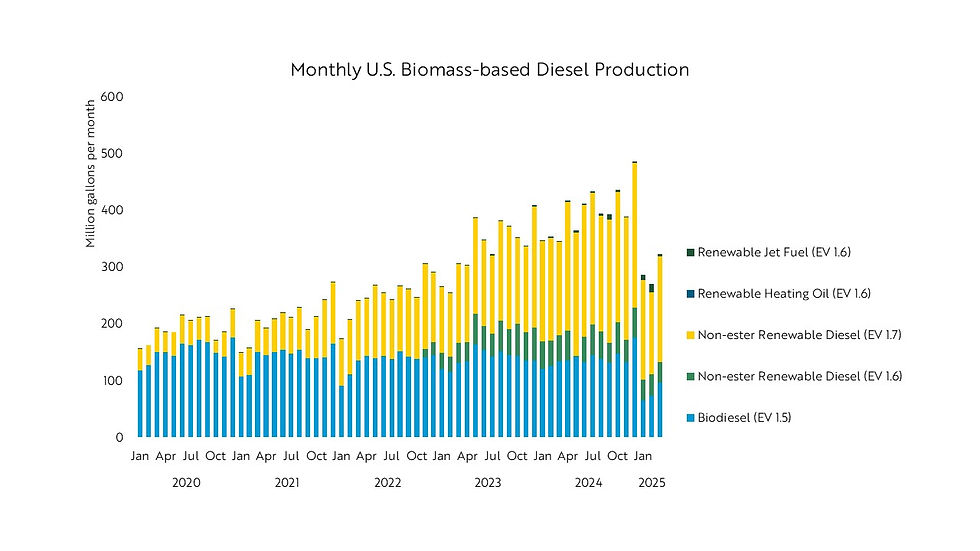RFS Stakeholders Unite
- Paul Winters
- Jun 18, 2025
- 4 min read

With interested parties agreeing on robust RFS volumes for biobased diesel, EPA is further encouraged to unleash growth of domestic energy.
After a decade and a-half of annual regulatory, legal and political donnybrooks over Renewable Fuel Standard volumes, the renewable fuel and petroleum industries have joined hands to support robust, timely 2026 volumes.
In March this year, Clean Fuels Alliance America, farm and feedstock groups sent a letter asking U.S. EPA to set 2026 biobased diesel (BBD) volumes at 5.25 billion gallons. Later the same month, Clean Fuels, the American Petroleum Institute, American Soybean Association, National Oilseed Processors Association and ethanol trade groups met with EPA to present agreed-upon volumes for the 2026 rule—including the 5.25-billion-gallon BBD volume.
In April, Clean Fuels launched a six-figure advertising campaign to back up the industry’s advocacy efforts and build support for a timely bump in BBD volumes to 5.25 billion gallons for 2026.
Unity on BBD volumes was easy to achieve in a few ways. American fuel producers, soybean processors and oil refiners have invested billions of dollars over the past five years to increase U.S. biodiesel and renewable diesel production. According to a new report from GlobalData commissioned by Clean Fuels, capacity for biodiesel, renewable diesel and SAF could expand to 7.4 billion gallons in 2026 if current projects move forward. The industry’s capacity is already at 6.5 billion gallons—so the BBD industry could meet the requested 2026 volume with just 75 percent of existing capacity.
Higher volume requirements are needed to revive languishing biodiesel production as well as to encourage producers to turn SAF enthusiasm into real gallons. Clean Fuels is also advocating a BBD volume of 5.75 billion gallons for 2027 to accommodate this anticipated growth*.
The feedstocks to produce the volumes in America are available. According to an analysis by S&P Global on behalf of NOPA, the soybean-processing industry has invested more than $6 billion to expand or build 20 crush facilities across 10 Midwest states. The investments will support 1.4 billion additional gallons of U.S. production by 2030—with enough capacity coming online by 2026 to support the 5.25-billion-gallon goal. The U.S. biodiesel and renewable diesel industry used more than 1 billion pounds of domestic soybean oil each month throughout 2024—an increase of 15 percent since 2022. That level of demand supported $1.10 in value for every bushel of soybeans grown in the United States.
Demand for BBD is strong and still growing. The U.S. market for biodiesel, renewable diesel and SAF topped 5.1 billion gallons in 2024. Moreover, in its April 2025 Annual Energy Outlook, the U.S. Energy Information Administration projects demand to reach 5.5 billion gallons in 2026. Six major U.S. rail companies joined Clean Fuels’ membership in the past year because the sector is looking for a readily available decarbonization tool—and biodiesel and renewable diesel fit the bill. Shipping companies are also interested in adopting cleaner fuels. Biodiesel and renewable diesel are drop-in fuels for marine vessels. Airlines, the heating-oil industry and fleets across the country continue to seek more clean fuels.
Continued growth of the U.S. BBD industry will bring economic value to farmers, feedstock producers and fuel producers. According to Clean Fuels’ GlobalData report, the U.S. BBD industry supports 107,400 jobs and contributes $42.4 billion to the U.S. economy. Nearly half of the economic impact—$19.9 billion and 41,500 jobs—is in fuel production. But the U.S. BBD industry also supports 30,600 jobs in oilseed production, bringing a $15.3 billion economic impact to soybean-growing states. There are major employment impacts for oilseed processors (8,600 jobs) as well as the rendering industry (12,700 jobs), according to GlobalData.
There’s more economic growth and employment at stake in the next few years. According to GlobalData, if the U.S. BBD industry reaches 7.4 billion gallons of capacity, it could support 145,700 jobs and $60.25 billion in economic activity at full capacity.
“We have seen the cost to rural communities when [renewable volume obligation (RVO)] levels are set too low,” a bipartisan group of 16 senators wrote EPA Administrator Lee Zeldin in an April letter. In the aftermath of the 2023-’25 RFS volumes for BBD and advanced biofuels, which EIA noted were set “significantly below production trends,” biodiesel and renewable diesel facilities shuttered, delayed start-up and laid off workers. Uncertainty over the new tax credit served as the final nail for many companies, but the low RVOs in the “set” rule prepared the groundwork. Producers did not purchase soybean oil, tallow and other U.S. renewable feedstocks for the first quarter of 2025, undercutting agriculture markets.
With unity among RFS stakeholders on the RVOs for 2026 and 2027, EPA Administrator Zeldin can finalize volumes that meet growing U.S. energy demand, unleash American energy producers from regulatory constraints, and support domestic economic growth. And RFS stakeholders will be appreciative.
*Editor’s Note: This article was published in the Summer 2025 issue of Biobased Diesel®, which was printed shortly before EPA issued its 2026 and 2027 RVO proposal.

Author: Paul Winters
Director of Public Affairs and
Federal Communications
Clean Fuels Alliance America
202-737-8803


































